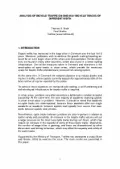-
Past ETC Papers

Browse, search and view papers from the past AET Conferences.
-
Members' Area

AET promotes networking and exchange of ideas, information and opportunities amongst members.
Conference Papers 2015
Frankfurt, Germany
ETC Conference Papers 2015
Analysis of bicycle traffic on one-way bicycle tracks of different width
Seminar
Day 1 (28 Sep 2015), Session 5, Cycling: design, behaviour and technology, 17:00 - 19:00
Status
Accepted, documents submitted
Submitted by / Abstract owner
Thomas Buch
Authors
Thomas Skallebæk Buch, Trafitec, Poul Greibe, Trafitec
Short abstract
The project contributes with new knowledge about relations between width of bicycle tracks and behavior, flow and capacity of bicycle traffic. Based on speed and lateral position capacity is calculated and width of bicycle tracks has been recommended
Abstract
This abstract is based on a project conducted by the Danish consulting firm Trafitec Aps and funded by the Danish Ministry of Transport. The purpose of the project is to contribute with new knowledge about relations between width of bicycle tracks and behavior, flow and capacity of bicycle traffic. One goal is to recommend width of bicycle tracks.
Background
The focus on bicycle traffic is growing due to cyclists’ contribution to a greener environment and better health. It calls for investments in bicycle infrastructure, but traffic planners lack knowledge about the influence of width of bicycle tracks on e.g. capacity of bicycle traffic. Previous investigations in this area are quite few and have shown different results e.g. a 2-lane bicycle track is found to have a capacity varying between 2,000 and 10,000 bicycles pr. hour and average speed on bicycle tracks vary between 10 and 25 km/h. Danish capacity standards which also are used e.g. in the American Highway Capacity Manual are based on data from around 1940. Furthermore odd size bicycles might influence behavior on tracks.
Methodology
Empirical data has been collected at 8 different bicycle tracks of varying widths (1.85m-2.85m excl. curbs between bicycle track and carriageway). Typically, the width of curbs is around 15 centimeters in Denmark. Different requirements have been set up before choosing locations. The main criteria are high bicycle traffic volumes on the tracks, no traffic lights / junctions / bus stops / zebra crossing nearby, and no dividing verge between bicycle track and carriageway.
The traffic is observed by video recordings during rush hours. The speed has been measured between two points around 20 meters apart. At one of the points lateral position has been measured. The study distinguishes between ordinary bicycles (“traditional” bicycles, racing bikes, mountain bikes, e-bikes) and special bicycles (cargo bikes, tricycles, bicycles with trailer). The study includes 8,925 cyclists.
Results
The relation between lateral position and the width of bicycle tracks has been investigated both for cyclists during overtaking and for cyclists in free flow. The lateral position is also investigated depending on traffic volumes e.g. low volume (1-4 bicycles pr. 10 seconds) and high volume (8-12 bicycles pr. 10 seconds). Parked motor vehicles along the bicycle track seem to influence the “effective width of bicycle track”. This means that a part of the bicycle track is not used compared to a bicycle track of the same width but without lateral parking along the track.
Average speed among cyclists on ordinary bicycles and special bicycles are measured and compared. Furthermore, speed and lateral position is compared. It is also investigated how traffic volume affects average speed.
The cyclists tend to arrive at the observed sites in groups more or less controlled by traffic lights on their route. This means that high traffic volumes are observed in quite short time spans e.g. up to 20 bicycles pr. 10 seconds. The hourly capacity of a 2-lane bicycle track is calculated controlling for the fact that during short time spans you might observe higher capacity. Due to non-existing controlling factors based on bicycle traffic this is done by comparing the observed data with motor vehicle data at the capacity limit. Despite a low number of special bicycles an attempt is made to investigate how these bicycles influence capacity.
Based on observations of lateral positions a minimum width of a 2-lane bicycle track is found. This is done for bicycle tracks with no or very few special bicycles and for tracks where a cyclist has the opportunity to overtake special bicycles. Furthermore a recommended minimum width of a 2-lane bicycle track is found. This recommended width is expected to provide the cyclists with a higher service level due to more space around the cyclists.
Documents:

Association For
European Transport
Forester House
Doctors Lane
Henley-in-Arden
Warwickshire, UK
B95 5AW
+44 (0) 15 64 793552
VAT number: 710 1866 64
Conference Supporters & Endorsers




Legal Entity
The Association for European Transport is registered as an Association ('vereniging') with the Chamber of Commerce for Haaglanden in The Netherlands under company number 27170096.
Built on Zenario




